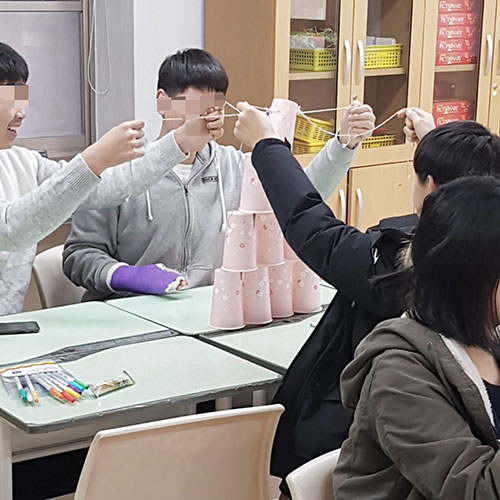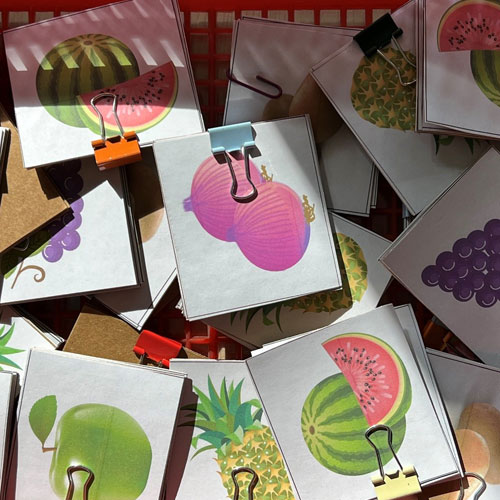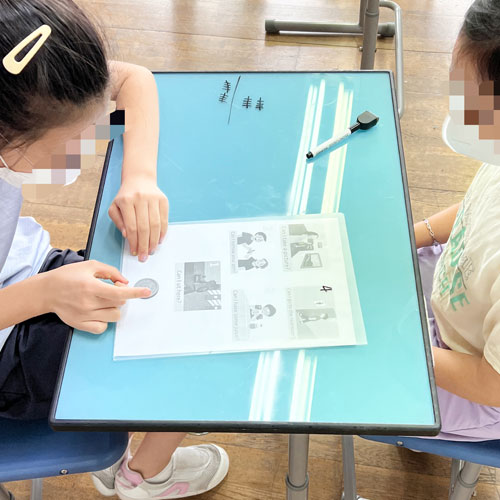-
Together Again
Simple Lesson Plans for This Stage of the GameElizabeth MacDonald
When Covid began, our lessons shifted toward safe individual games and activities. Pre-pandemic, many of us EPIK teachers had tons of great go-to lively group materials, right? Now that regulations have been partially eased in an official way… what were those materials again? The following are some of my simple no-fail group games that I’ve been reincorporating into classes. These ideas would also be perfect for those teaching face-to-face English camps this season. I’ll be sure to send my lessons along to any readers who message the email listed below!
Tower Time -Here is a classic ice-breaker activity that encourages cooperation between a small group of students. It is always a hit and can be used for any age group. One 4/5 person team requires a rubber band with 4 or 5 strings tied to it, as well as enough paper cups to make a pyramid. Each student holds one string, stretching the circumference of the band into a larger circle shape to quickly pick up and stack the upside down cups. The team to make their pyramid fastest wins. Review simple English verb phrases before the race, so that students can ask each other to "Pull now!", "Drop it now!" for example, without switching into Korean.
MASH - Another great activity is an updated version of MASH, the game you may know from childhood. This game is meant to be a fun prediction of future life. MASH ties in well with any lesson where you may be teaching future tense verbs. Give students a category paper with sections such as job, number of children, future partner, etc. Allow them to fill in some of their own choices (among your own pre-filled in examples to get them started). Instead of the circle doodle to decide the final option for each category, use dice. Students roll a number, scroll through the list, and cross that number option off, until one future prediction remains for each category. Remind your class that it’s just a silly and fun game! In my experience, kids often like to choose animation characters for their ‘future partner’ section, which is just fine of course.
A Perfect Board Game – Board games are not exactly ground-breaking in terms of teaching materials, but this Snakes and Ladders game in particular has an appealing layout, is large in size, and makes kids motivated to win. The rules are straight-forward! If you land on a snake head, travel down the board, if you land on a ladder bottom, go up! In 3-4 person groups, students can review any and all vocabulary or key sentences – just mark some spaces as ‘card’ spaces on the board. When students land on those, they pick up a card and complete the prompt to practice the English corresponding to the lesson. I like to use this board game for reading practice in particular.
Circle Says – This one is an active game that is inclusive of everyone in the room. When teaching younger grades, it’s a nice activity to practice color vocabulary. If teaching later grades, it works well with the text-book chapters that focus of describing appearance. Clear a space free of desks and ask students to bring one chair to form a circle of chairs. The teacher stands in the center, and indicates which people have to get up and find a new seat to sit in. For example, “..wearing green!” or “..has long hair!” etc. Students who fit the profile should switch, and try not to be the one left in the middle. The middle student continues by giving a new prompt. This activity is just plain fun! I like to continue to play together with kids. Remind them not to push, or target anyone in particular.
Coin Flick – Sometimes the simplest games are the most effective! This speaking game provides a great opportunity for a small culture lesson, and keeps kids talking and entertained. Make a board that has 5 or 6 evenly-spaced image prompts for any key words or phrases that you’re teaching. Also put points numbers on each image. At the bottom of the page, mark a line or circle. To play, a student aims for one image by first speaking the key sentence that the picture depicts. Then, placing a plastic, cardboard, or real coin on the bottom marking, the student flicks it to try to reach that picture. If at least 50% of the coin makes it there, the student receives their points. This game works best in pairs or groups of three. Before the game starts, you may choose to briefly introduce a coin from your home country, and the meaning behind the symbols on it.
Email : eamacdonaldworkplace@gmail.com
English Program in Korea(EPIK)
National Institute for International Education Ministry of Education, Republic of Korea
191 Jeongjail-ro, Bundang-gu, Seongnam-si, Gyeonggi-do, 13557 Korea Tel : +82-2-3668-1400 Fax: +82-2-764-1328






